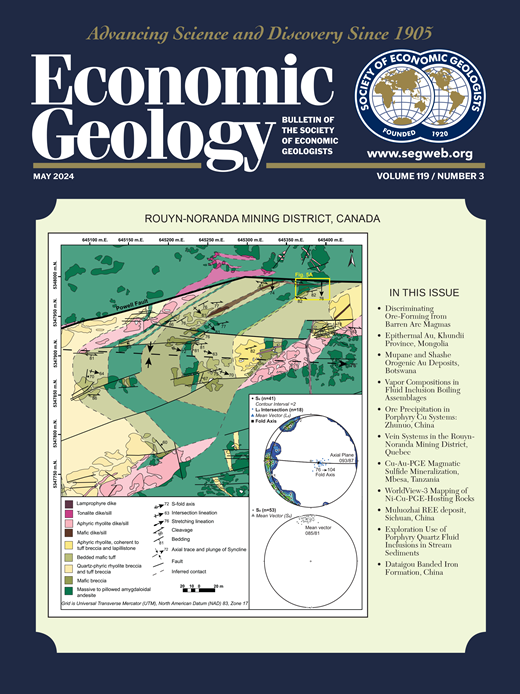面向锂伟晶岩勘探的土壤地球化学:基于便携式x射线荧光构建机器学习预测算法
IF 4.9
1区 地球科学
Q1 GEOCHEMISTRY & GEOPHYSICS
引用次数: 0
摘要
随着对锂(Li)需求的增加,需要更便宜、更可持续、更快速的方法来识别和表征新的锂矿床。富锂伟晶岩是锂的主要来源,但其勘探往往受到土壤覆盖的阻碍。便携式x射线荧光(pXRF)可以快速准确地量化土壤化学,以确定基岩的经济潜力,但不幸的是,通过pXRF无法检测到Li。基于15个预测因子(K、Rb、Al、Ba、Ca等)的丰度,利用pXRF数据和随机森林模型对土壤样品和富锂土壤母质中的Li含量进行了预测。为了进行比较,还进行了支持向量回归和神经网络深度学习。该数据集包括112个土壤样本,收集自美国威斯康辛州北部和密歇根州森林覆盖、冰川覆盖的富含锂辉石的伟晶岩、贫瘠的花岗伟晶岩、过铝花岗岩和变质主岩。利用电感耦合等离子体光学发射光谱(ICP-OES)独立测量锂丰度。神经网络对锂离子的预测效果最好,其决定系数(R2)为0.90,均方根误差(RMSE)为~40 mg × kg-1,剩余预测偏差为3.2。采用随机森林预测亲本材料的模型效果最好,总体精度为0.88。便携式XRF分析区分在基岩上形成的具有不同矿物学的土壤样品。使用pXRF结合适当的机器学习模型来预测土壤中的锂含量和下垫基岩的类型,与传统的挖沟相比,可以成为一种更有效、侵入性更小的替代勘探方法。本文章由计算机程序翻译,如有差异,请以英文原文为准。
Soil Geochemistry Toward Lithium Pegmatite Exploration: Building a Machine-Learning Predictive Algorithm via Portable X-Ray Fluorescence
As demand for lithium (Li) increases, cheaper, more sustainable, and faster methods are needed for the identification and characterization of new Li deposits. Lithium-rich pegmatites are major sources of Li, but their exploration is often hindered by soil cover. Portable X-ray fluorescence (pXRF) can rapidly and accurately quantify soil chemistry to determine the bedrock economic potential, but unfortunately, Li is undetectable via pXRF. Herein, pXRF data and random forest models were used to predict both Li contents in soil samples and Li-rich soil parent material based on abundances of 15 predictors (K, Rb, Al, Ba, Ca, etc.). For comparison, support vector regression and neural network deep learning were also conducted. The data set consisted of 112 soil samples collected over spodumene-rich pegmatites, barren granitic pegmatites, peraluminous granite, and metamorphic host rocks from forested, glaciated northern Wisconsin and Michigan, United States. Lithium abundances were independently measured using inductively coupled plasma-optical emission spectroscopy (ICP-OES). The best Li prediction was achieved using neural networks, yielding a coefficient of determination (R2) of 0.90, a root mean square error (RMSE) of ~40 mg × kg–1, and residual prediction deviation of 3.2. The best parent material prediction model was achieved using random forest, with an overall accuracy of 0.88. Portable XRF analysis discriminates among soil samples formed on bedrock with distinct mineralogy. Using pXRF combined with appropriate machine learning models to predict the Li contents in the soil and the type of underlying bedrock could become an alternative, more efficient, and less invasive exploration method compared to traditional trenching.
求助全文
通过发布文献求助,成功后即可免费获取论文全文。
去求助
来源期刊

Economic Geology
地学-地球化学与地球物理
CiteScore
10.00
自引率
6.90%
发文量
120
审稿时长
6 months
期刊介绍:
The journal, now published semi-quarterly, was first published in 1905 by the Economic Geology Publishing Company (PUBCO), a not-for-profit company established for the purpose of publishing a periodical devoted to economic geology. On the founding of SEG in 1920, a cooperative arrangement between PUBCO and SEG made the journal the official organ of the Society, and PUBCO agreed to carry the Society''s name on the front cover under the heading "Bulletin of the Society of Economic Geologists". PUBCO and SEG continued to operate as cooperating but separate entities until 2001, when the Board of Directors of PUBCO and the Council of SEG, by unanimous consent, approved a formal agreement of merger. The former activities of the PUBCO Board of Directors are now carried out by a Publications Board, a new self-governing unit within SEG.
 求助内容:
求助内容: 应助结果提醒方式:
应助结果提醒方式:


